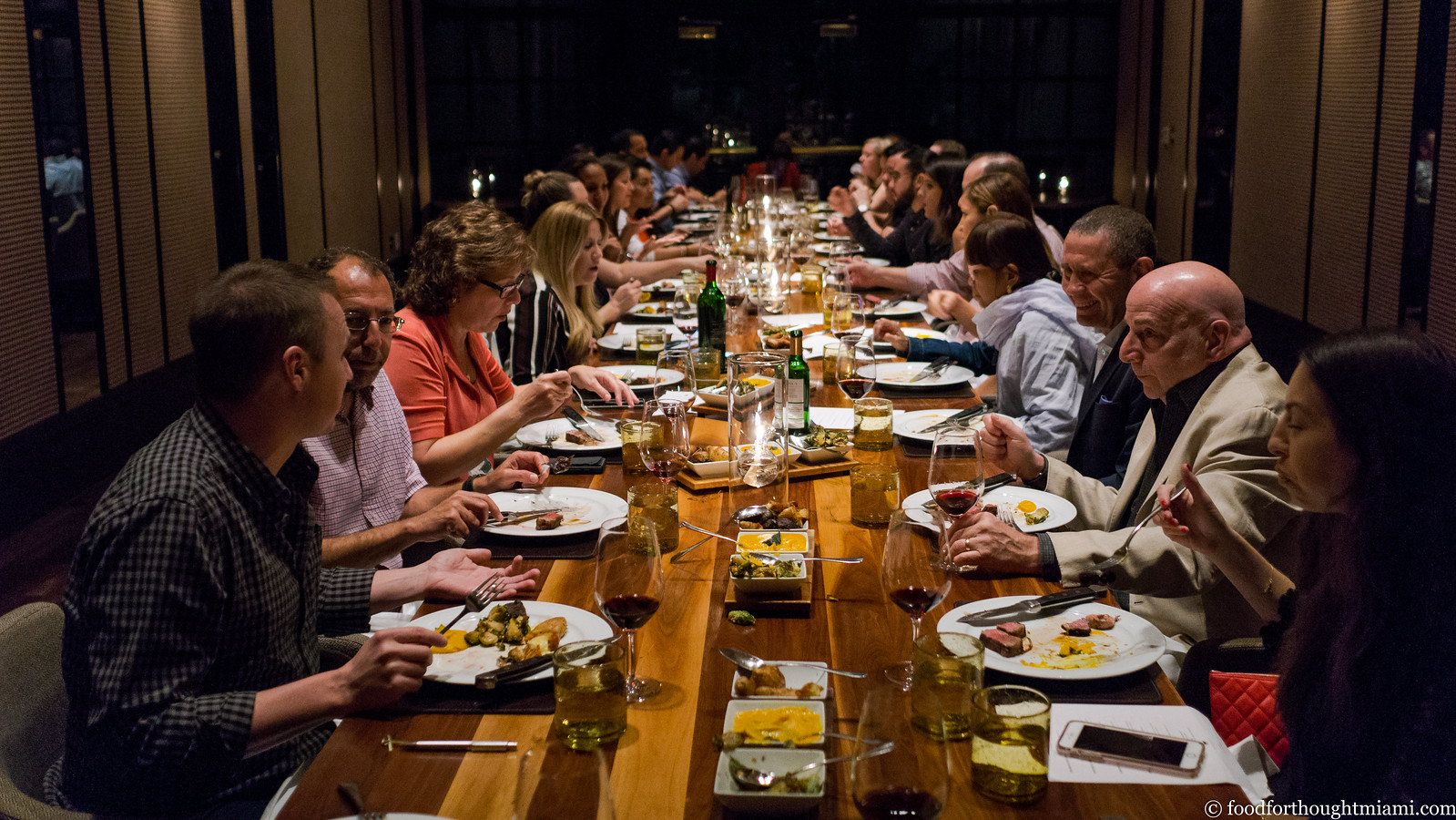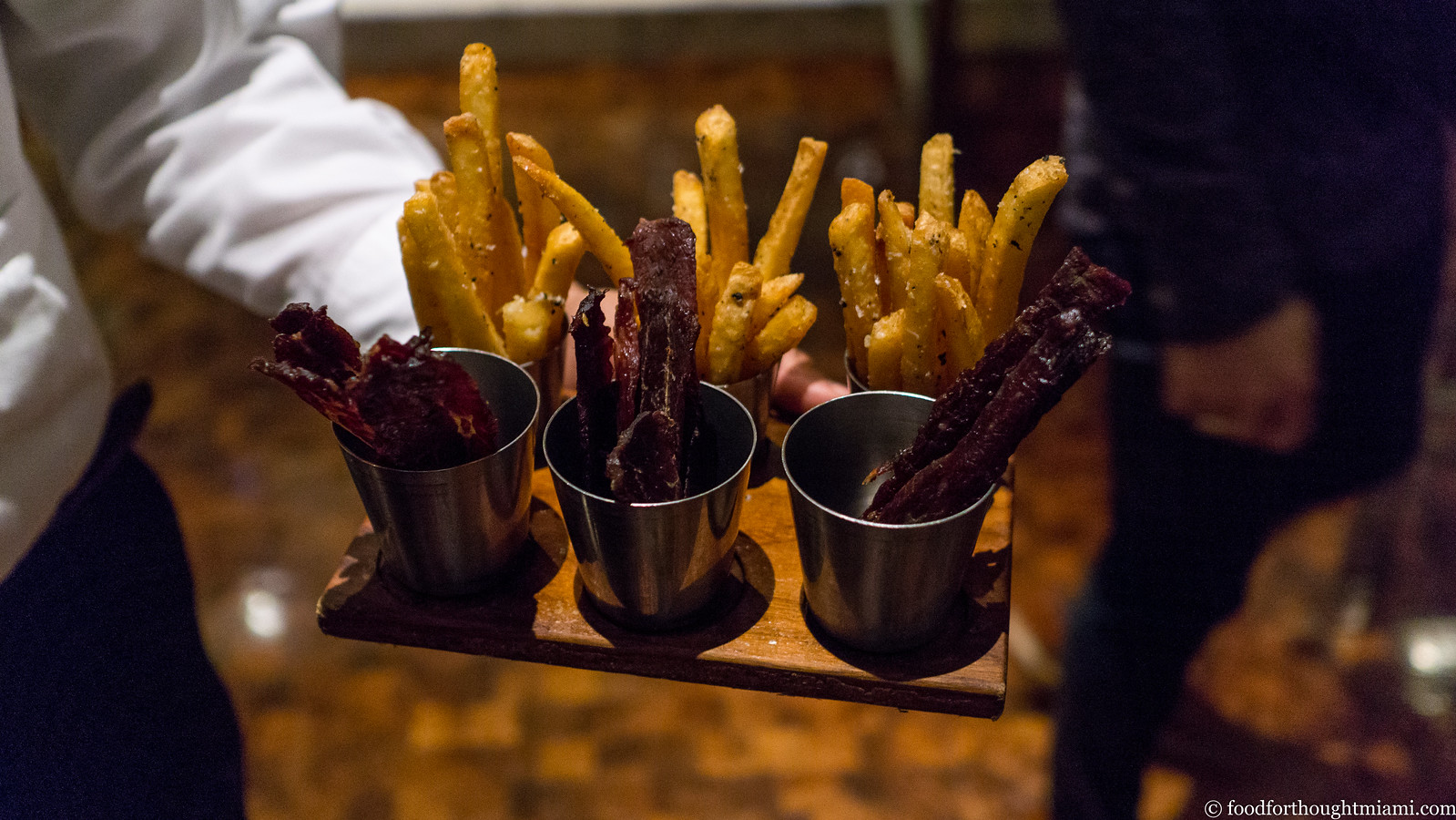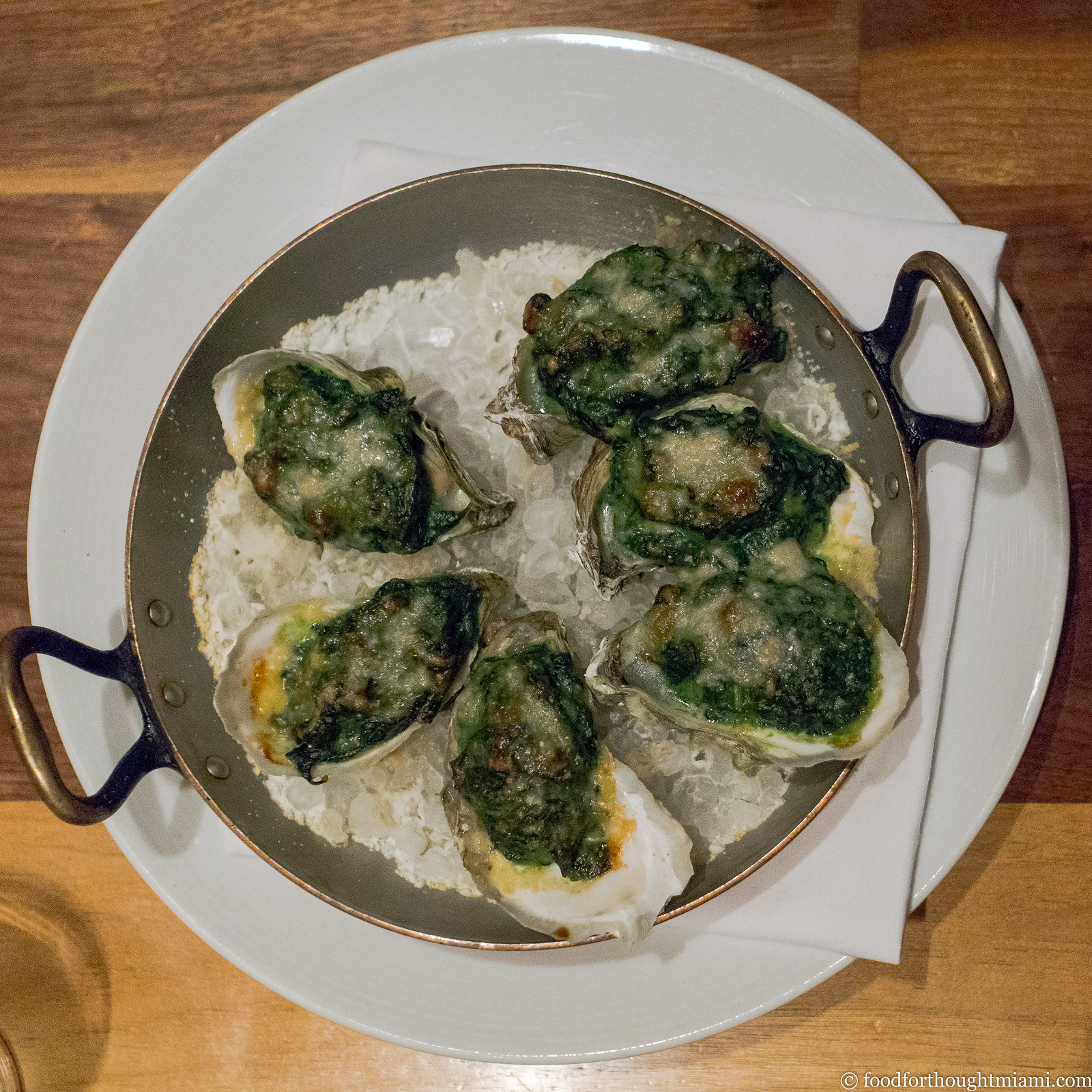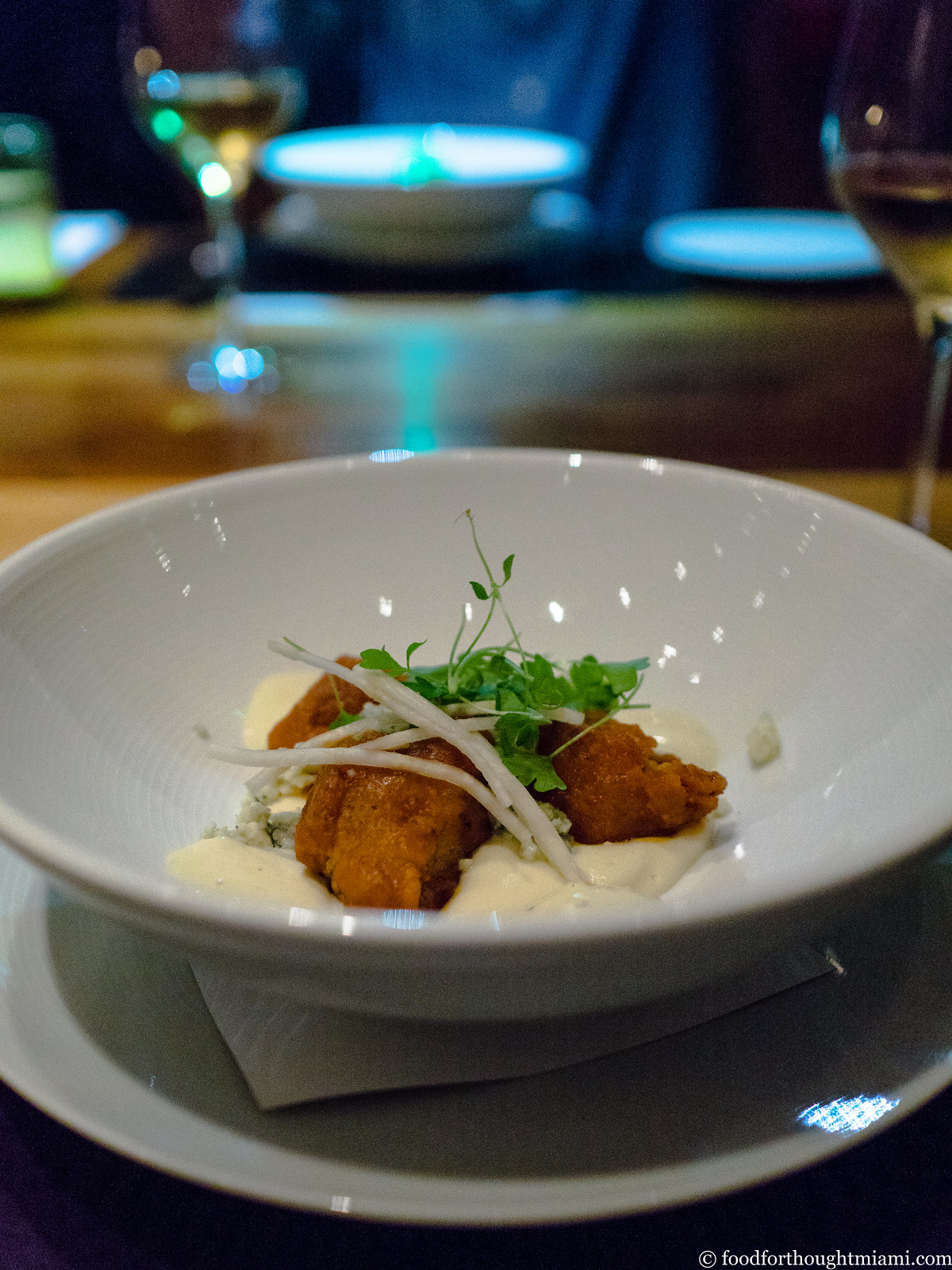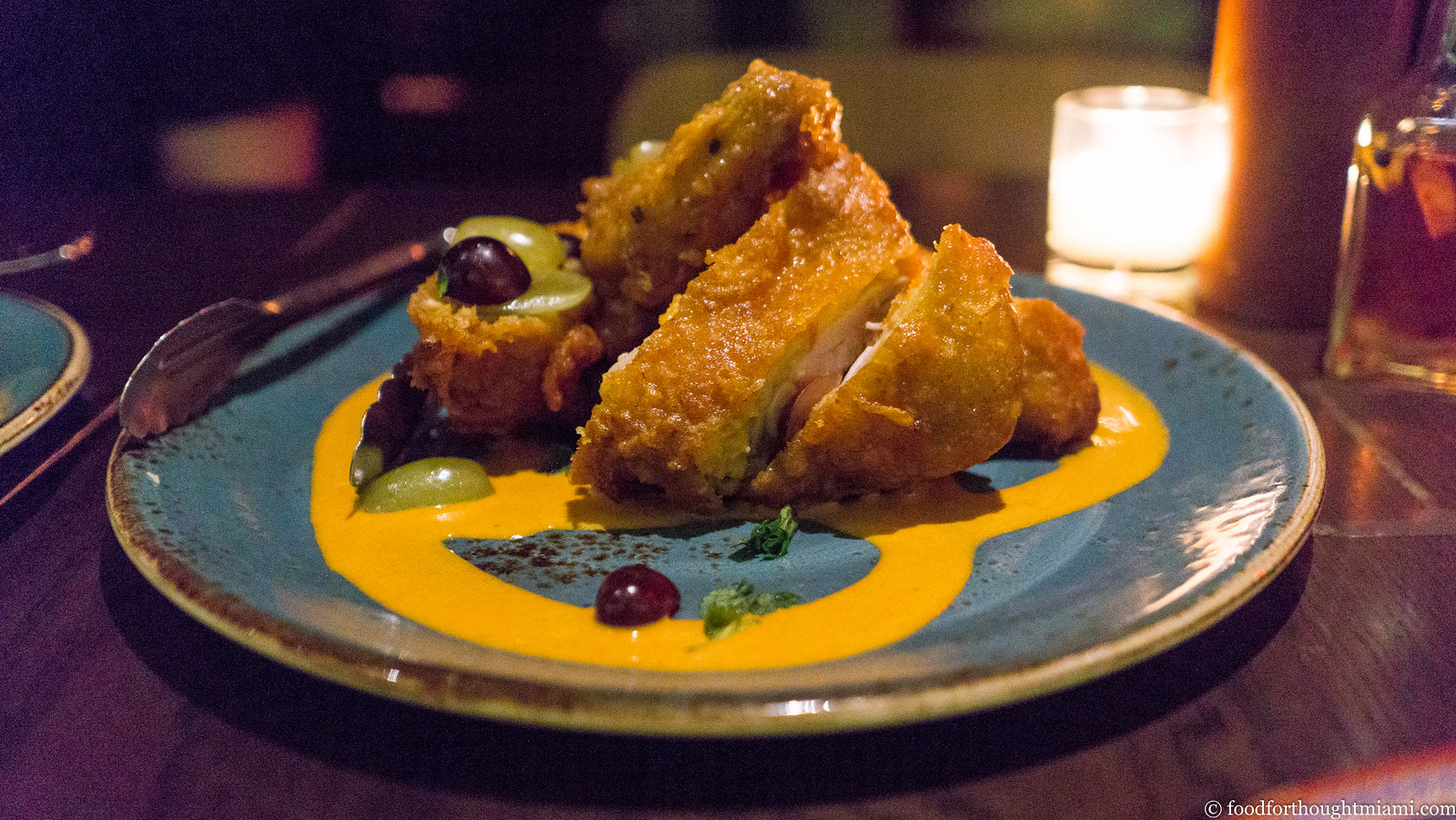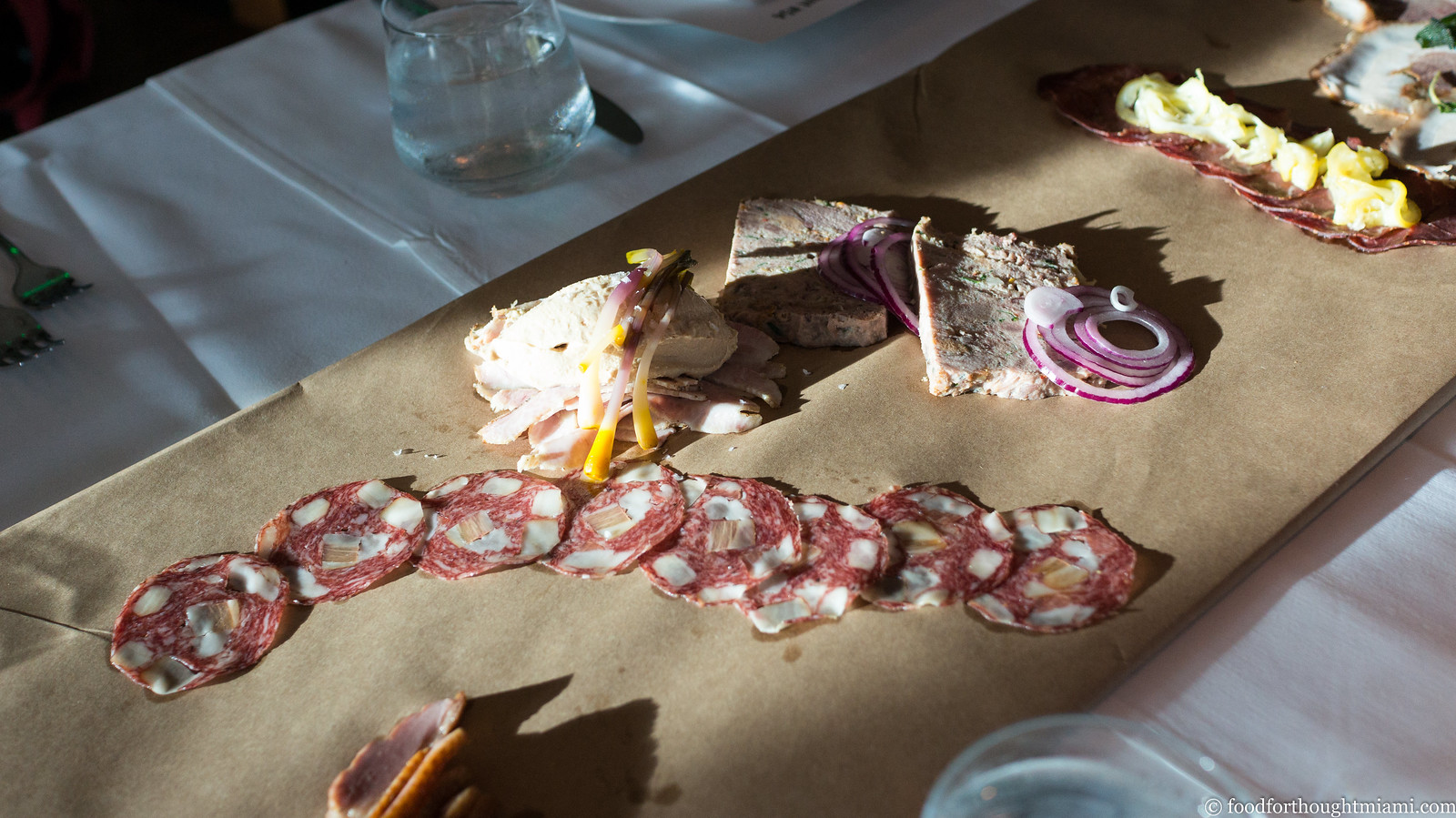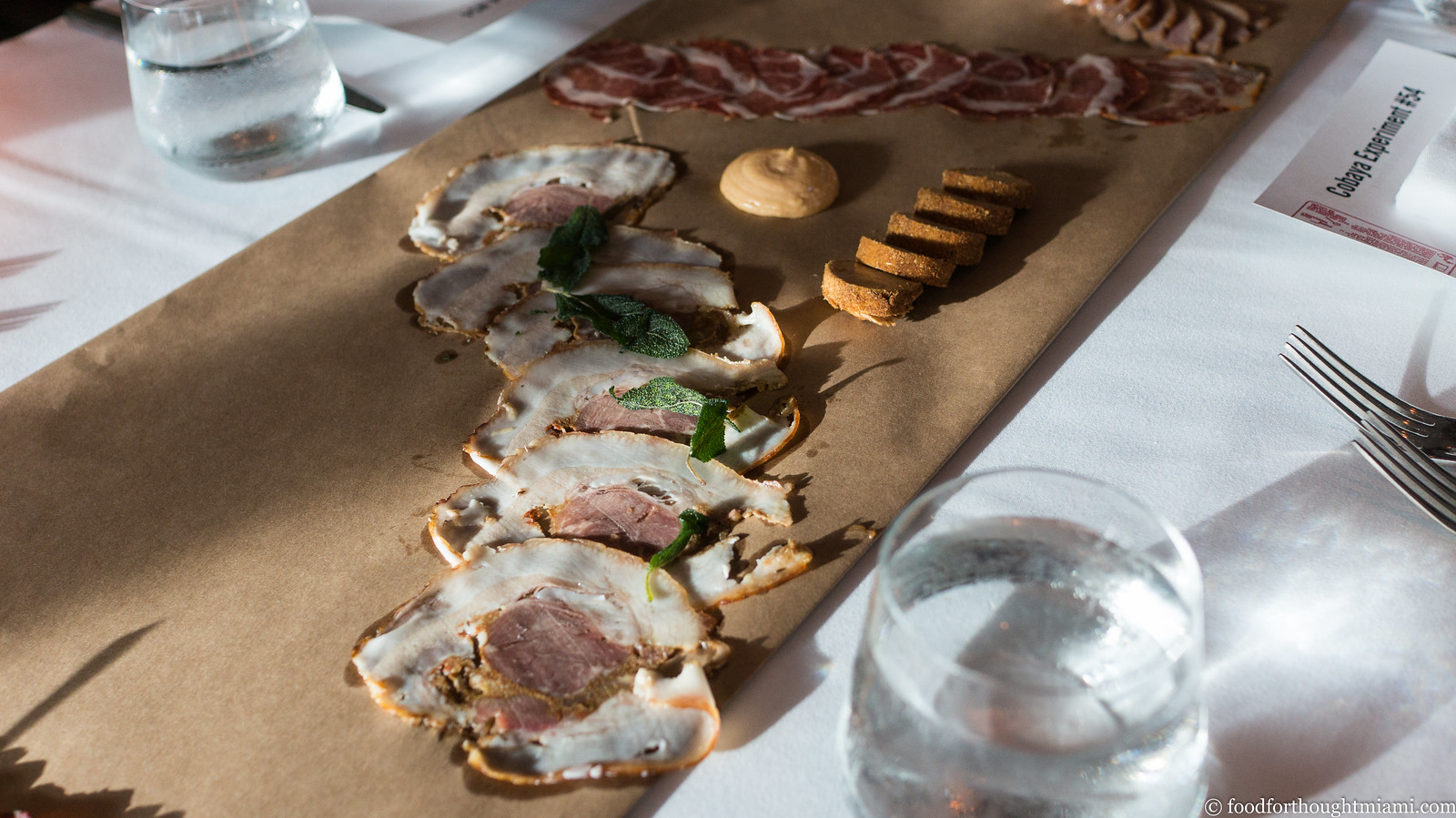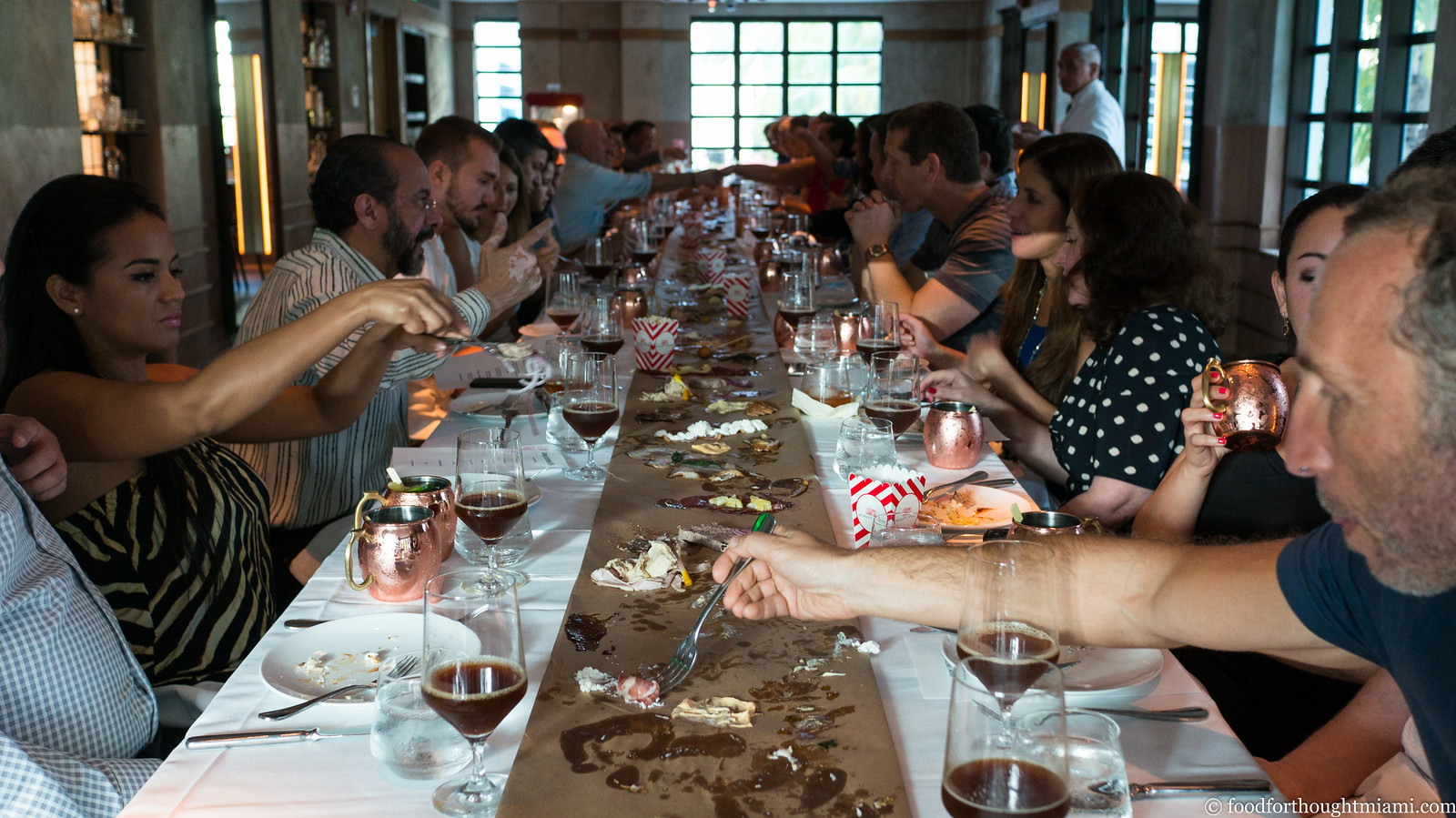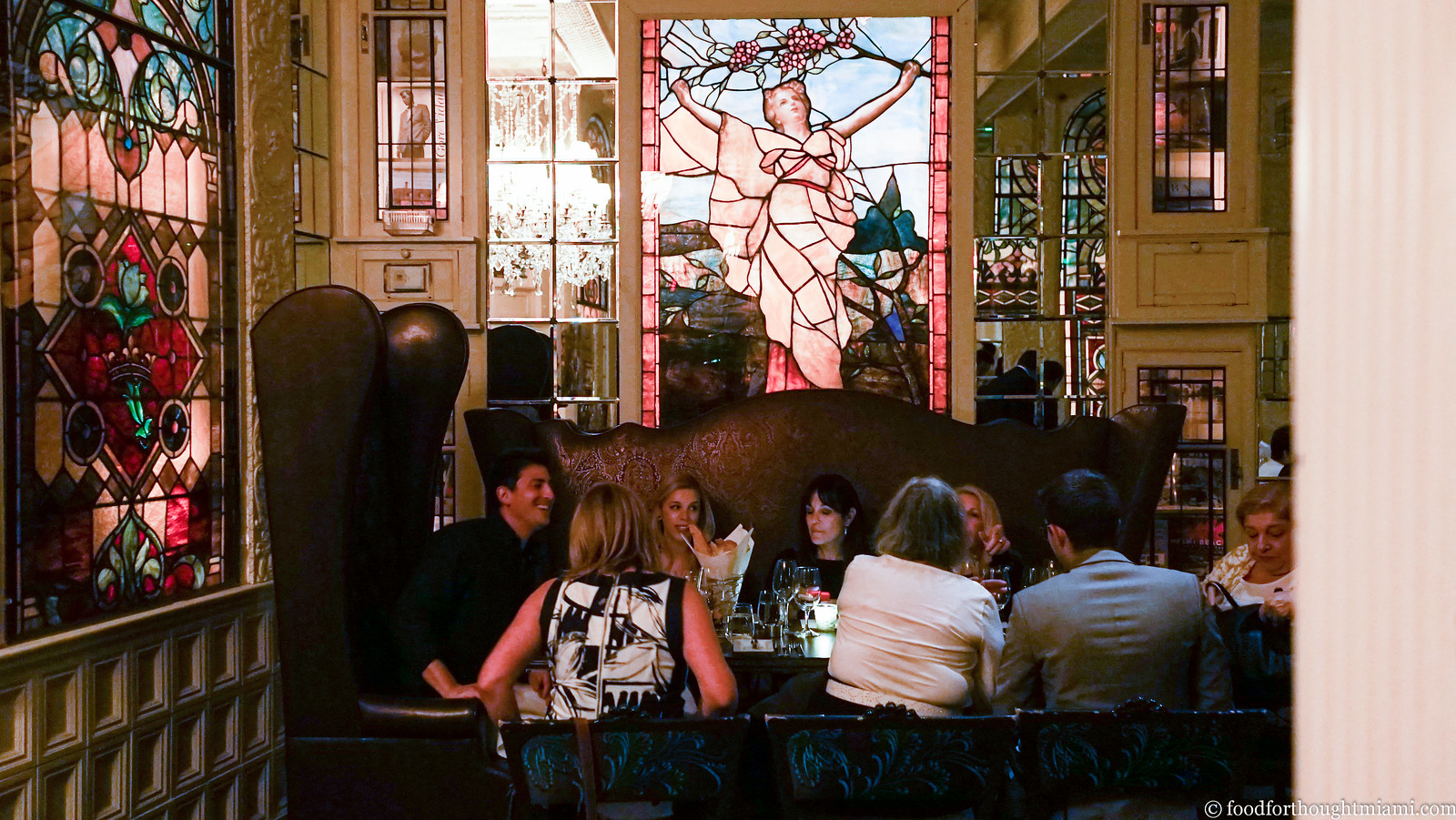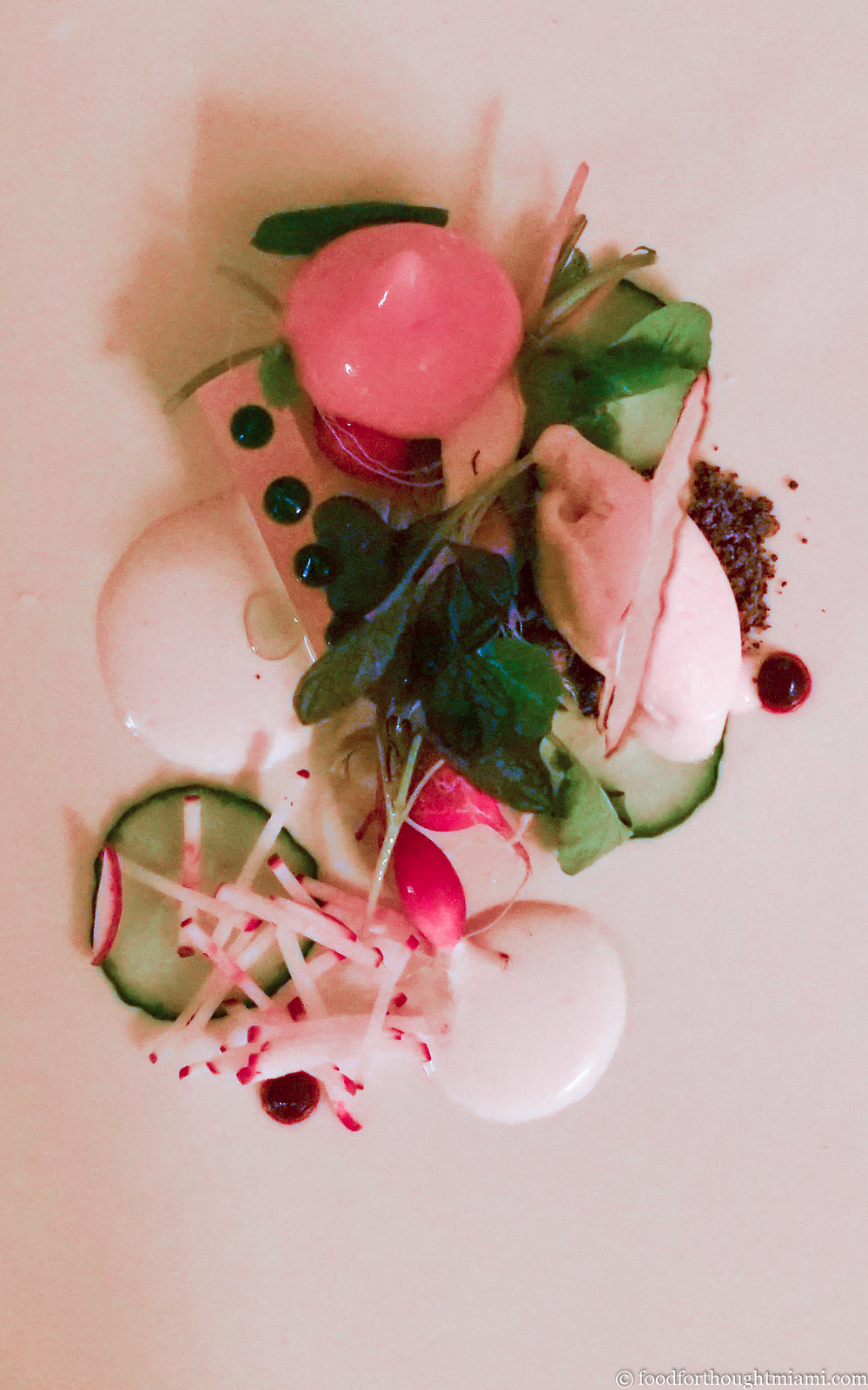Monday, October 24, 2016
Cobaya Gabe at Bourbon Steak
It's hard for me to believe it's been six years. But sure enough, it's been that and then some since our first Cobaya dinner with Chef Gabriel Fenton of Michael Mina's Bourbon Steak in Aventura, back in May 2010. That was only our sixth experiment, and in our eagerness to push chefs to work outside of their comfort zones, we told Gabe that he could cook whatever he wanted – as long as it wasn't steak. It was our bit of rebellion against the then-common trend of big-name chefs opening nothing but steakhouses in Miami.[1]
It was a great dinner, but man, was that dumb.
We've been looking to make a repeat visit for some time, and it finally happened last week. This time around, we told Gabe – who I think is one of South Florida's most skilled chefs – he could really cook whatever he wanted.
That was smart.
(Full set of pictures can be seen in this Cobaya Gabriel Fenton flickr set).
We started the same way every meal at Bourbon Steak starts: with some of their outstanding duck fat fries, here, dusted with truffle and accompanied by some candied bacon. While we usually insist that everything at our dinners be off-menu, these (1) are not actually on the menu at B.S.; and (2) would be worth making an exception anyway. Also making the rounds as folks gathered at the bar was some hearty antelope chili, served with fingerling potato chips, and flavorful Florida grass-fed beef satay skewers.
Once we settled into B.S.'s private dining room, dinner started with oysters a few different ways: Wianno oysters on the half-shell, garnished with ponzu and a brunoise of green apple, and also with crispy shallot and a coin of chorizo (?); and, even better, a really excellent rendition of classic Oysters Rockefeller.
Next, something you wouldn't likely ever find on the menu at Bourbon Steak, but executed at the exact same level: buffalo sweetbreads. The delicate, cloud-like sweetbreads were encased in a crisp shell laced with hot sauce, and served over a silky celery root purée topped with crumbled Pt. Reyes blue cheese.
(continued ...)
Monday, May 23, 2016
best thing i ate last week: parrillada at Los Fuegos
Months ago, I made my first visit to the new Faena Hotel, to try out Chef Paul Qui's restaurant, Pao (some first thoughts on Pao here). I was equally intrigued by its sibling at the Faena, Francis Mallmann's Los Fuegos, but hadn't made my way back. Mallmann, if you're unfamiliar, is a larger-than-life character who runs several restaurants in Argentina, and literally wrote the book which has inspired a new wave of interest in open-fire cooking. (For a good introduction, this episode of Chef's Table featuring him is highly recommended).
I pass up 99% of the freebie meal offers I get via FFT, but an invite to a Sunday asado at Los Fuegos was too good to pass up. So full disclosure and all, but hopefully I've built up enough credibility that you'll believe me when I tell you this was great stuff. Our afternoon junket took us through most of the Sunday menu, which is typically a $75 affair with several choices among three-plus courses. On special occasions (Father's Day is coming up ...) it will likely be more expansive, more expensive, and more family style, like what we were served.
There were lots of highlights – the wood oven baked empanadas, the grilled sweetbreads given a black-edged hard sear and a squeeze of burnt lemon, the bubbling provoleta with crusty bread – but the centerpiece was the parrillada, and the real standouts for me, the crisp-edged, tender-fleshed lechoncito, and the oozy, rich morcilla sausage.
(You can see all my pictures in this Los Fuegos by Francis Mallmann flickr set.)
I'll be back on my own dime soon.
Runner-up: the ultra-crispy Korean fried chicken, served in a puddle of kimchi-spiced yogurt, at Talde Miami Beach.
Monday, July 6, 2015
best thing i ate last week: charcuterie at Quality Meats
There was a smoked soppressata, topped with a cornbread cream. There was suckling pig coppa di testa, topped with fried sage leaves. Cured foie gras torchon, rolled in malted barley and a mango gastrique. A hearty pork headcheese with rounds of slivered onion. Hickory smoked duck bacon. Coppa, topped with aerated mozzarella. Calf liver mousse with pickled ramps. Merguez "prosciutto" topped with preserved lemon. Pork jowl corn dogs with tabasco mayo. Popcorn drizzled with melted dry-aged beef fat. All of it made in-house, all laid out up and down a roll of butcher's paper stretched along a forty foot table as we entered the room.
It was the best thing I ate last week. (You can read more about the dinner here).
Friday, July 3, 2015
Quality Cobaya with Chef Patrick Rebholz
We were in a private second-floor room in the old Bancroft Hotel on South Beach, a beautiful property whose Art Deco features have been pretty respectfully preserved. It's now the home of the Miami outpost of Quality Meats, a New York restaurant with some historical legacy itself: its owners opened the original Smith & Wollensky steakhouse in New York in 1977.[1]
The chef was Patrick Rebholz. Before joining QM, Rebholz had spent most of the past decade cooking in Charleston, most recently as the chef de cuisine at the Peninsula Grill. We got a hint that Chef Rebholz had big plans for his Cobaya dinner when he asked for an early start time. Sure enough, we didn't wrap up until nearly four hours after our 6:30pm commencement. It was time very happily spent.
(You can see all my pictures from the dinner in this Quality Cobaya flickr set).
After milling around at the bar while our group assembled, we were escorted upstairs to the "Bancroft Room" and its wafting meaty aromas. Moscow Mules in gleaming copper mugs were handed out to everyone. All the chairs were pushed back from the table so that Rebholz and crew could more easily make their way through to apply some finishing touches: cornbread cream on top of the smoked soppressata; aerated mozzarella on top of the coppa.
There was plenty more: silky, intense cured foie gras torchon coated with malted barley and a mango gastrique; thin-sliced suckling pig coppa di testa and hearty headcheese; merguez "prosciutto" topped with preserved lemon; creamy calf liver mousse topped with pickled ramps; pork jowl pastrami; hickory smoked duck bacon; toasty pork jowl corn dogs with Tabasco mayo; popcorn dressed in dry-aged beef fat. Rebholz poured some of his house-brewed beer too, and it was a great match with the charcuterie.[2]
It was a crazy good way to start a meal, and folks dug in pretty rapaciously. Then Chef Rebholz just rolled the paper down to clear the table.[3]
(continued ...)
Wednesday, May 13, 2015
Cobaya Lee at the Forge
The Forge is one of the true grand dames of the South Florida restaurant world. And like a lot of grand dames, it's had a bit of work done here and there over the years. Originally opened in the 1930's, it was the mid-century Miami hangout of choice for celebrities like Frank Sinatra and Jackie Gleason. In the 1960's, Alvin Malnik bought it from the original owner (a blacksmith, ergo the name), and remodeled it in the luxe, rococo style that has become its signature. Malnik – with a little help from Baron Philippe Rothschild – also was responsible for filling out its encyclopedic wine cellar. In the 1990's, after son Shareef Malnik took over from his father, the Forge was not only regarded as one of the city's top restaurants – it also was one of Miami's hottest party scenes with its Wednesday disco nights.
Since then, it's had at least one more substantial redecoration about five years ago, lightening up some of that old polished mahogany. It has brought some new life into the kitchen as well: Dewey LoSasso did a turn there, and more recently Chef Christopher Lee took over the reigns. Chef Lee has a pretty full résumé for a guy who's still in the prime years of his career: in 2005 he was the James Beard "Rising Star Chef of the Year;" the following year, after moving from Philadelphia to New York, he garnered two Michelin stars for (now-closed) Gilt; then a couple years later picked up another Michelin star at Aureole.[1]
So when Chef Lee expressed an interest in doing a Cobaya dinner, we were intrigued to see what he was doing these days – and eager to have an excuse to hang out in one of Miami's most opulent dining settings.
(I am abashed at the lousy quality of my photos from this dinner; I was trying out a new camera and am very disappointed with the results. So with my apologies, you can see all the pictures from this dinner in this Cobaya Forge flickr set).
Chef Lee started light, with a dish featuring radishes in a multitude of fresh, snappy, peppery forms, accompanied by puddles of a tangy goat cheese dressing and a quenelle of a bright orange and fennel sorbet.
(continued ...)
Thursday, November 14, 2013
CobayaBelly with Chef Jose Mendin at PB Steak
It's always interesting to see how chefs approach doing a Cobaya dinner with us. Having a "theme" is entirely optional, but many chefs choose to do so. When we lined up a dinner with Chef José Mendin, of Pubbelly and its sibling PB Steak, he went with a "Bloody Monday" motif.
The decorations seemed inspired equally by a butcher's abattoir and a goth chick's boudoir,with PB Steak's unfinished wood and concrete dressed up with lots of candles, black apothecary bottles and the occasional crow.
Chef Mendin's offal-intensive menu, making extensive use of the "fifth quarter" of the cattle whose prime cuts usually grace the restaurant's menu, was drawn up like a butcher's diagram, though the pieces actually came from several different places - beef heart from Niman Ranch in California, veal brains from Strauss Farms in Wisconsin, tongue from Jackman Ranch in upstate Florida, prime rib from Cox Family Farms in Alabama.
(You can see all my pictures in this CobayaBelly flickr set, though you'll have to put up with some wonky lighting and grainy shots.)
(continued ...)
Monday, July 4, 2011
1500 Degrees - Miami Beach
It would have been easy to dismiss 1500°, which opened last October in the Eden Roc Hotel. Its combination of steakhouse and farm-to-table themes could easily seem a cynical effort to simultaneously play both the lowest common demoninator and the latest trendy fashion of restaurant buzzwords. Its chef, Paula DaSilva, was perhaps better known for a stint on the culinary torture porn that is the Gordon Ramsay-hosted Hell's Kitchen than for her work as chef de cuisine of Dean James Max's 3030 Ocean in Fort Lauderdale. And hotel restaurants on the Beach, with limited exceptions, have generally not been the most fertile dining grounds of late.
And yet ...
And yet, 3030 Ocean was a fine restaurant when DaSilva was running it. And yet, that "farm-to-table" routine may be more than just lip service, with a menu that features many local products and artisan producers like Benton's Hams.[1] Maybe I should quit being so cynical and just try it. So I did, a couple times over the past couple months.
The truth is, 1500° really isn't much of a steakhouse at all. Yes, the name is a reference to the temperature of the broiler they use to cook their meats. But beef actually makes up only a small portion of the menu. In fact, the five steak choices (which include a mammoth 34 oz. porterhouse for two) are matched by an equal number of non-bovine entrées, and are vastly outnumbered by various, mostly non-beefy appetizers in various forms, and a plethora of vegetable sides. Which is a good thing: the steaks are OK, but the other stuff is mostly much better.
(continued ...)
Saturday, May 15, 2010
Cobaya Experiment #6 - CobayaSteak at Bourbon Steak
That's not to sell the steakhouses short. I've had some great meals at these places, and they have the capacity to serve as a springboard for younger kitchen talent (witness the nomination of Chef Sam Gorenstein of BLT Steak as a semifinalist for a James Beard Rising Star award this year). But the self-limiting format only gives so much wiggle room for the local chefs to show that they can do something other than grill a steak and cook potatoes.
That's in part what Cobaya is for: to give chefs a chance to showcase, or experiment with, things they may not be able to do in their "native habitat." When we met with Bourbon Steak's chef Gabriel Fenton and general manager John Riccardo, we told them that this was a no-holds-barred opportunity to cook whatever they wanted to make, and if there wasn't a single piece of steak on the menu, that was perfectly fine. And Chef Fenton - who spent several years as executive sous chef at Michael Mina's flagship restaurant in San Francisco - put together a beautiful meal in which a cow made only the briefest cameo appearance. We hardly noticed its absence.
The menu (you can see all my pictures from the dinner in this flickr set):
(continued ...)
Wednesday, May 5, 2010
What's Your Beef?
Genuine Kobe beef, which comes from a particular breed of cattle (Wagyu) raised in a particular prefecture of Japan (Hyogo), is among the most prized (and expensive) in the world. In recent years, producers in other parts of the world have sought to duplicate the product, and there are now farmers in the U.S. and Australia who raise Wagyu and cross-breeds. The product is often quite good, though not of the same quality as the genuine Japanese article, and carries significantly lower prices. Though there seems to be a good bit of confusion, this is really not a complicated issue: if the beef doesn't come from Kobe, Japan, you shouldn't call it Kobe beef. As the article details, that simple rule is supported by Florida's Department of Business and Professional Regulation, which said:
The use of the term Kobe beef on a menu or special board is a misrepresentation. ... Use of the terms Wagyu beef, American-style Kobe beef, Australian-style Kobe beef, and (country of origin) Kobe beef are acceptable, providing the operator can provide supporting invoices and product to match.[1]It was a well-written and well-researched piece, and I'm happy to hear that it is in line for a Sunshine State Award from the South Florida Society of Professional Journalists.
When the matter was brought to several restaurateurs' attention during the writing of the article, many of them claimed to be unaware and pledged to make immediate changes on their menu to correct the mislabeling. There's just one problem: it appears that virtually none of them have actually done so.
(continued ...)
Friday, April 9, 2010
The Forge - Miami Beach
The place has quite a history: supposedly, it was originally an actual blacksmiths' shop, and in the 1930's was turned into a restaurant and casino. It was purchased in the late 1960's by the Malnick family, who were responsible for an opulent renovation that made the place a landmark for the next several decades. The restaurant survived a fire in 1991 and extensive damage from Hurricane Andrew in 1992; but after a 40-year run, The Forge closed its doors in July of last year, supposedly to do a major renovation. Frankly, most who heard that were dubious. "Closed for renovations" actually means "closed for good" about 90% of the time, and those odds seemed even more stacked against The Forge, whose extravagant, big-ticket style seemed particularly out of step with the declining local and national economy.
But The Forge proved all the skeptics wrong when it reopened its doors this month, showing off a thorough redecoration of the space, and also bringing in a new chef (Dewey LoSasso, formerly the chef-owner of now-closed locals' favorite North One Ten) to run the kitchen. Both the renovation and the chef have breathed new life into an old classic.
The entranceway, previously gated, has been opened up, making for a dramatic catwalk into the restaurant, with sconces which could have been lifted from a Tim Burton set along the walls. The main dining room has been brightened up considerably with new blond-stained wood paneling on the walls and new tables and chairs throughout (some in gigantic Alice in Wonderland proportions). A wall of glass beads separates a second dining room, and around the corner is a glassed-in private dining room as well as the "Library," an intimate little room with a gas-lit fireplace and stained glass all around. It's perhaps just a tad less ostentatious than the original pre-renovation Forge, but it will certainly never be described as minimalist.[*]
Chef LoSasso's menu is similarly ornate. Fans of North One Ten will recognize some of Dewey's signature dishes, like his smoked salmon croquettes with "damn hot guava sauce," but it seems the surroundings - and, obviously some encouragement from the owners - have inspired the chef to explore any number of flights of fancy. Indeed, while the Forge still serves several steaks, it would be misleading to call it a steakhouse now. The menu is too far-reaching to fit into that narrow pigeonhole.
(continued ...)
Monday, April 5, 2010
III Forks - Hallandale
As a result, you don't see a ton of negative reviews here. I tend to have a pretty good sense of when I'm not going to like a restaurant, and can usually avoid those where I'm likely to be disappointed. Likewise, if a place is merely mediocre, there's often not much of interest to be said about it.
But sometimes my sense of foreboding is not enough to save me from a bad meal. Sometimes, even if you're not a professional critic, you can't choose where you eat. I recently had one of those times, when friends made a reservation at the newly opened III Forks in the Village at Gulfstream Park complex.
If you haven't been down that way lately, you will be astounded at what's gone up on the massive plot of land that houses the Gulfstream horse track. In addition to the newly renovated track and adjoining casino, there is a Vegas-scale shopping complex with several restaurants. Aside from III Forks, there is a new Douglas Rodriguez restaurant opening soon (Ola Cuban), a Texas de Brazil, and maybe ten other big restaurants in the development (most still not yet open). The magnitude of it is pretty staggering. And the track itself is really just beautiful. We recently brought the kids to watch a couple races, and it was a great way to spend a sunny afternoon.
Anyway, as I almost always do, I checked out the online menu for III Forks before our visit. I immediately started whining to Mrs. F that it was the most soul-crushingly boring menu I'd seen in years, and desparately tried to find ways to alter our plans. But sometimes there's no polite way to do so. So, into the abyss ...
(continued ...)
Thursday, July 2, 2009
A Tale of Two Steakhouses - Bern's, Tampa; BLT Steak, South Beach
"It was the best of times, it was the worst of times."
For South Florida diners, it might well be the truth. On the one hand, we are fortunate to have local talents like Michael Schwartz, Michelle Bernstein and Jonathan Eismann at restaurants that are reflective of each chef's personal vision and style, and seem to be finding an audience both with locals and the seasonal tourists. We've also had a massive influx lately of imported big-name restaurateurs making sizable investments in South Florida outposts, seemingly oblivious to the financial downturn (more likely simply the product of capital already committed before the economy turned south).
On the other hand, there seems to be a stultifying sameness to many of the new places, particularly the foreign imports. BLT Steak, Gotham Steak, Red the Steakhouse, the upcoming STK steakhouse ... do you see a trend here? But I'd be far from the first person to bemoan the fact that steakhouses are becoming as ubiquitous as Starbucks in Miami,[1] and won't do so further.
Instead, let me get to the point. A couple weeks ago, I had the good fortune - though a cardiologist might disagree - of visiting two fairly celebrated steakhouses. The first was Bern's Steak House, a Tampa institution for more than fifty years and regarded by many as one of the finest steakhouses in the country. The second was one of the new foreign imported models, BLT Steak in Miami Beach, one of many spokes radiating from the New York hub of the Laurent Tourondel empire. It made an interesting opportunity for a compare and contrast.
Bern's Steak House
Bern's looks about a hundred years older than it actually is, because it is decorated in the style of a 19th century brothel. I say that with respect and appreciation. The governing principle of the decoration is that if there is a surface, it should be covered with red velvet, gilt, or if in any way possible, both. It is quite a sight to behold and doesn't look much different than the last time I was there, which was probably more than 20 years ago. While clearly an old-school institution, the restaurant is not fixed in amber. Indeed, they were ahead of the locavore trend, and for years have run their own farm which supplies many of the vegetables used in the restaurant (which, being a steakhouse, is not a ton, but still ...).
Arriving there late, and solo, on a Monday evening, I asked to be seated in the more casual bar area in the front of the restaurant, and skipped the tour of the kitchen and wine cave that is customarily offered. I was brought a plate with a few crackers topped with some melted cheese, which looked unfortunately grey in the restaurant's dim light, and then was given the fat menu and the even fatter wine list. Bern's wine collection is possibly even more legendary than its steaks, with 6,800 selections and over a half million bottles. Only a portion of the collection is actually housed in the restaurant's cellar, with the rest stowed in a warehouse across the street. There are two things in particular I find especially appealing about Bern's wine list: (1) the incredibly deep collection of older American wines; and (2) the eminently reasonable prices for many of those wines, most of which were purchased by the restaurant upon their release.
If there is a hole in Bern's massive wine list, it is the absence of half-bottle options; but given the prices, it was fairly easy to splurge on a full bottle even if I was dining alone. I told my waiter that I was interested in trying a zinfandel with some serious bottle age on it, that I trusted Ridge as a producer, and that he ought to help pick something good as he was going to be finishing off the bottle himself after I was done. He steered me to a 1977 Ridge Coast Range Zinfandel (priced around $60) that another diner had recently tried and enjoyed (he kept a notepad in his pocket to keep track of such things), which was decanted at the table. The common wisdom is that zinfandel is not a wine that ages particularly well, and that most should be drunk within about five years of release. Ridge, however, has a reputation for producing age-worthy zin, and this wine certainly reinforced that reputation. Despite thirty plus years in the bottle, this wine was still fully alive and vibrant; not the jammy flavors of most current zins, but elegant and layered, with a nose that suggested fallen leaves and hints of mushroom and forest floor among the dark fruit notes. It was a thrill to find something this old, and this well-kept, at such a reasonable price.
I let the zin get some air while I started with a flute of Delamotte Le Mesnil Champagne and an order of American hackleback sturgeon caviar. Bern's offers 20+ different caviar selections in one-ounce portions, ranging from various flavored whitefish or tobiko roes for $25 to $220 Iranian Oscetra. The hackleback, one of my favorites of the American sturgeon roes, comfortably resided much closer to the lower end of that range. Along with some toasted brioche, it came with accompaniments that I found highly amusing - six different flavored foams! That most stereotypical and loathed conceit of the so-called "molecular gastronomists," here in this seriously old-school steakhouse? Say it isn't so! Does this mean we should now call Bern's Steak House a "molecular gastronomy restaurant"?[2] Unfortunately, I can no longer recall all six flavors (lemon; onion; avocado; curry .... ?) but after sampling each, I stuck with the lemon or just a bare naked scoop of roe on the brioche.
I elected to skip the soup which comes with every entrée and moved on to the salad. I usually do not care much about fussy service, but I am still a sucker for touches such as the chilled fork that was brought out with the salad. I believe my server said the salad had 12 different vegetables, many from the Bern's garden, but I have to confess that none particularly moved me.
Next arrived what I had really come for - the steak. The steak portion of the Bern's menu takes up a total of five pages, and includes an explanation of each cut (and how Bern's butchers each - all butchery is done in-house and to order); pricing for various weights of each different cut (ranging from a 6 oz. filet mignon to a 60 oz. New York strip); a detailed description of the degrees of doneness you can request; and a lengthy discussion of their in-house dry-aging process. I went with a 10 oz. rib-eye, and it was one of the finest steaks I've had in a long time. The beef was clearly the beneficiary of good dry-aging, rendering it tender with a deep concentration of flavor. Most remarkable was that it had been trimmed so that there was not a bite on this steak that wasn't edible. I actually like the "cap" on a rib-eye, which is usually separated from the rest of the steak by a thick line of fat, but this was trimmed like what I have more recently seen described as an "eye of rib-eye." When I mentioned to my server (after devouring every bit of the steak) that I liked the cap, he told me to just say so on my next visit, as every steak is cut to order and can be butchered basically however you want.
The steak was accompanied by a perfectly pleasant baked potato with all the fixings, some slightly flaccid, soggy onion rings, as well as some rather nebbish vegetables from the Bern's garden - some shredded sauteed carrots with a hint of sweetness, which just seemed odd, and a few different types of wax beans, which were given an incongruous splash of soy sauce. I didn't save room for a trip to the "Harry Waugh Dessert Room."
The truth is, I could have easily lived without everything at Bern's but the steak and the wine; but with just those two things, I could have had an incredibly satisfying meal. All the more remarkable considering that the rib-eye I ordered - which came with an onion soup, salad, baked potato, onion rings and vegetables - was $40. I know that seems like a steep price point to be talking about a "bargain," but relatively speaking - and particularly once the wine prices are factored in - that might well be an apt description of Bern's.[3]
BLT Steak
Visually, at least, BLT Steak is the anti-Bern's. Stationed in the lobby of the Betsy Ross Hotel on the northern end of Ocean Drive in South Beach, BLT Steak is the embodiment of minimalism, a stark contrast to the baroque excess of Bern's. The space draws lots of natural light from the windows facing out on Ocean Drive, and everything is terrazzo, blond wood, and beige linen. The primary "decoration" is a large blackboard behind the banquettes inscribed in chalk with a tutorial on different types of beef. It is a surprisingly small space, with a bar off to one side, about a dozen or so tables in the main lobby space (which still also functions as the Betsy Hotel lobby), and another row of tables in a narrower space along the windows facing Ocean Drive. There's also outdoor seating on the front patio.
Whereas at Bern's I could have just stuck with the steak and the wine and happily skipped everything else, it was the "everything else" that made for some of the biggest highlights at BLT Steak. Indeed, one of the best things was one of the first to arrive at the table, a jam jar filled with warm, oozy chicken liver mousse, along with a similar jar of lightly pickled vegetables and some crusty bread. I don't know many people that enjoy chicken liver (at least not as much as I do), but I hope they're at least willing to try this - it may make them converts. These treats were followed by a tray with a gigantic popover for each diner, delicately crispy outside, tender and warm but not mushy or doughy within. I would be hard pressed to pick a favorite pre-dinner steakhouse spread between this and Bourbon Steak's trio of duck fat fries and truffle-oil soaked focaccia.
| photo credit: Jacob Katel |
In addition to the regular menu, which doesn't stray very far from the usual steakhouse staples (although it does offer more fish and seafood selections than usual, both in the appetizers and entrées), there was also a separate menu of daily specials which appears designed both to give the chef (the all-of-25-years old Samuel Gorenstein) an outlet for more creative fare, and to take advantage of seasonal local product. The specials menu offered both prix fixe and a la carte options, but I felt like I needed an abacus to figure it all out. The prix fixe offer included three courses plus a side dish (I believe it was for $60), theoretically from any of the items listed on the specials menu, but at least half the items had "supplement" charges if ordered as part of the prix fixe, ranging from $3 to nearly $20. Feeling too mentally taxed to figure it all out, we simply went a la carte.
I started with one of the daily specials, a porchetta di testa. It was amusing to see that this was the exact same preparation as the one done by Chef Chris Cosentino of Incanto in San Francisco, as shown in this video; and one that I have already seen duplicated, in almost exactly the same manner, right down to the garnishes, by Chef Michael Schwartz at Michael's Genuine. One more dish to add to my list of "goes around ... comes around" items, apparently. It was good, possibly even a bit more refined than MGF&D's iteration, and I have no complaints with finding pig head on multiple local menus.
Mrs. F started with a classic shrimp cocktail, something that's often good but tough to make really sing. In fact the only time I've ever had a truly standout shrimp cocktail was at Bourbon Steak (which, it seems, I need to go back to), where an extra dimension was added by a poaching liquid redolent with tarragon and other fresh herbs whose flavors were beautifully picked up by the crustaceans. The shrimp at BLT Steak were plump and sweet but not particularly special.
| photo credit: Jacob Katel |
Frod Jr. and I split a 40 oz. porterhouse, an impressive cut roughly two inches thick, with the sirloin and filet on either side deftly trimmed off the bone and sliced into big slabs. It was done closer to medium rare than the medium/medium-rare I'd requested (for Frod Jr.'s benefit), but the heat from the pan actually provided for some carry-over cooking of the slices left within. It was a good steak (though an unfortunate seam of fat running the length of the sirloin side was a distraction), with a nicely charred exterior from broiling at 1700 degrees (!), but lacked the depth of flavor (and the conscientious trimming) of the steak at Bern's. A pat of herb butter on top was unnecessary, and a head of roasted garlic seemed very 1980's. We did have plenty of leftovers, and Frod Jr. and I had a steak sandwich, and a steak sandwich, for lunch the following day. We even tried to put it on the Underhills' bill. And that head of garlic actually came in handy to flavor a roasted garlic mayo for the sandwiches.
Mrs. F and Little Miss F elected to split a swordfish - a decision I didn't fully support, particularly given the rather uninspiring menu description as "spiced grilled swordfish / olive oil & lemon." The only thing missing was the "spiced," and this was a bland dish if generously portioned. There were other intriguing fish options, including an acacia honey marinated Alaskan black cod and some local fish selections in the daily specials.
As sides, we ordered some "crispy gnudi" from the specials list, along with onion rings and creamed spinach from the regular menu. The gnudi didn't really work for me, the exterior not so much crispy as just a bit gummy, and the rest of the components not really seeming to come together - a scatter of thinly sliced speck on top, a ramekin of butter on the side. The onion rings were big fat rounds of sweet onion, with almost a tempura style coating, stacked impressively into a tower. The creamed spinach was no better or worse than any other steakhouse version.
Desserts were a big hit among the junior members of the Family Frod. The real surprise hit was a key lime panna cotta which Little Miss F ordered. Served in a big glass bowl, the panna cotta was quiveringly light but bright with zippy key lime flavor, topped with a creamy coconut sorbet that was an effective pairing. Frod Jr. can almost never pass up a molten chocolate cake, and was sucked in by the one on the specials list. I've had these too many times to get excited by them, but he's still young.
The wine list, unsurprisingly, is no match for the list at Bern's. While fairly short, it manages to offer more options than just the typical panopoly of big California cabernets that are usually prevalent on steakhouse lists. The markups were wildly unpredictable, however. A 2006 Ridge Three Valleys zin, typically around $20 retail, was priced at $70+; on the other hand, a 2006 Alain Graillot Crozes-Hermitage, at $49, was less than 2x the average retail price of $30. Guess which one we got? (Hint: it was not the "base-model" current release from the same winery which produced a nicely 30+ year-aged wine that I bought for less at Bern's earlier in the week). The Graillot, a reliable Northern Rhone syrah, was a great match with the steak.
Service at BLT Steak was smooth and solicitous, belying the stereotype of apathetic or worse South Beach service. Though it was quiet for a Friday night, sometimes those slow service nights seem to trigger a certain inertia in the staff. Not true here. The servers cooperated in taking care of tables, the manager stopped by mid-meal to check on us, and the sommelier complimented us on the selection of the Graillot. It's not often that somebody notices and comments favorably on a wine from the low end of the list's price range.
So what's the point? I suppose there are a few. (1) overall, I had very pleasant meals at both Bern's and BLT Steakhouse; (2) despite both being "steakhouses," they are quite different places, with their own strengths and weaknesses, and perhaps it's too simplistic to simply lump all the "steakhouses" together; (3) despite my prejudices against steakhouses and even moreso those that are imported satellites, Bern's steaks and wine list alone are worth the visit, and BLT Steak is doing enough right to be worth checking out again - if for no other reason than the chicken liver mousse and popovers.
Bern's Steak House
1208 S. Howard Avenue
Tampa, FL 33606
813.251.2421
BLT Steak
1440 Ocean Drive
Miami Beach, FL 33139
305.673.0044
[1]In fact, there are now more steakhouses in Miami Beach than there are Starbucks. The Starbucks locator shows 9 stores in Miami Beach. Steakhouses? BLT Steak; Fogo de Chao; Gotham Steak; Parilla Liberty; Outback Steakhouse; Prime One Twelve; Rare Steakhouse; Red; Shula's; Smith & Wollensky; Texas de Brazil = 11. And that's not even counting recently closed Kobe Club and Tuscan Steak, or soon-to-open STK.
[2]Regular readers will know I don't think there is any such thing as a "molecular gastronomy restaurant" and hopefully the use of techniques such as foams in an old-guard restaurant like Bern's helps prove the point.
[3]One oddity of Bern's is that the bill includes a 12% service charge "to be given to your waiter in lieu of salary," with a note that "The option of a gratuity for fine service, of course, is yours." I frankly had no idea what to make of this rather ambiguous notation, and added about another 10% to the bill as tip - in addition to the glass or so I left behind of the Ridge zin my server had recommended.

